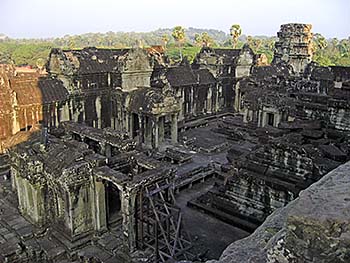The Grand Cultural Park
Angkor Archaeological Park is a huge, 400km2 large area which encloses a number of the great temples of the medieval Angkorean empire. Among them are Angkor Wat, the most visited sight in Southeast Asia, Angkor Thom with the Bayon and a number of other sights, Ta Prohm, Preah Khan, Banteay Srei and many more bigger and smaller temples, ponds, medieval hospitals, walls and city gates. The park also includes remarkable cultural landscapes.
Angkor Wat

Cambodia's icon, symbol, national pride: Angkor Wat, here the inner court seen from the central prasat. Image by Asienreisender, 2006
The medieval Khmer empire lasted from 802 CE to 1431 CE and stretched for centuries over considerable parts of Southeast Asia. Angkorean ruins are to find over whole Cambodia and parts of Laos and Thailand. However, the biggest concentration and the most important of the Angkorean temples are concentrated in the area of Angkor Archaeological Park. This was the heart of Angkor, and it was the place where most of it's capitals were situated.
There are very few guesthouses in the park itself (the only few I saw were at the northern shore of the royal pond Sras Srang. Therefore the nearby boomtown Siem Reap is the entrance gate to the park, with plenty of accommodation and tourist facilities of all kind, all popped up in a very few recent years. Siem Reap also has an international airport. Millions of visitors come every year to visit the great temples. The main entrace to the park is just four or five kilometers north of Siem Reap.
The climate of Angkor is tropical-monsoonal, means it's all over the year pretty hot and in the rainy season very humid. Recommendable for touring the park are light clothes with long sleeves and pants for sun and mosquito protection and plenty of water.
Angkor Cultural Landscape

Angkor Archaeological Park is huge, and the distance between the temples is often several kilometers. The landscapes are also minted by large water basins (barays), forests and rice fields. Image by Asienreisender, 10/2015
Angkor's Multi-Million Dollar Business
Of all the million people who visit Cambodia's touristic flagship Angkor Wat and the other great temples annually, few ask where actually the collected fees go. Every foreign visitor has to pay 20 US$ for a single day ticket, 45 US$ for a three-day ticket and 60 US$ for a seven-day ticket. Count it up and it goes into the millions. The first idea coming into the mind of the most might be that the money is spent for restoration and maintaining the monuments and the huge park.
On the tickets appears the name of the operating company, what is Sokha Hotels Ltd. Sokha Hotels is a subsidiary company of the Sokimex Group, who gained also the rights to build a whole new casino city in the national park of Bokor Mountain. Sokimex got the right of ticketing Angkor in 1999, while no competing company was accepted. It was agreed then that the company pays an annual flat tax of 1 million US$ to the Cambodian government. The Sokimex Group is owned by the tycoon Sok Kong, who is close to primeminister Hun Sen.
Cambodia is a country which ranks very low in international transparency comparison. Sokimex hides all figures about the ticketing income carefully secret. The Apsara Authority, who runs the park's administration, claimed for 2012 a revenue of 51 million US$. It remained open, where the money ended up.
A parliamentarian from the oppositional Cambodian National Rescue Party argues that about 80 percent of Cambodia's tourists do visit Angkor, and most of them buy a three-day pass. With an average tourist paying 30 US$ it would end up in total to 150 million US$. Part of the money would certainly go to the Apsara Authority for maintainance and paying staff, but the lion's share would not. He argues that approximately 120 million US$ would drain into private pockets.
When sightseeing Angkor it's obvious that the temples are restored by international organizations, who place information signs at the entrance to the sight they care for. The Bayon is cared for by Japan Apsara, Baphuon was restored by a French organization, Ta Keo by a Chinese, Banteay Srei by the Swiss goverment and Ta Prohm by an Indian. It's never Cambodian. Certainly Sokimex pays the staff who guards the temples and charges the entrance. But they don't get much money - that might be 30 US$ per month.